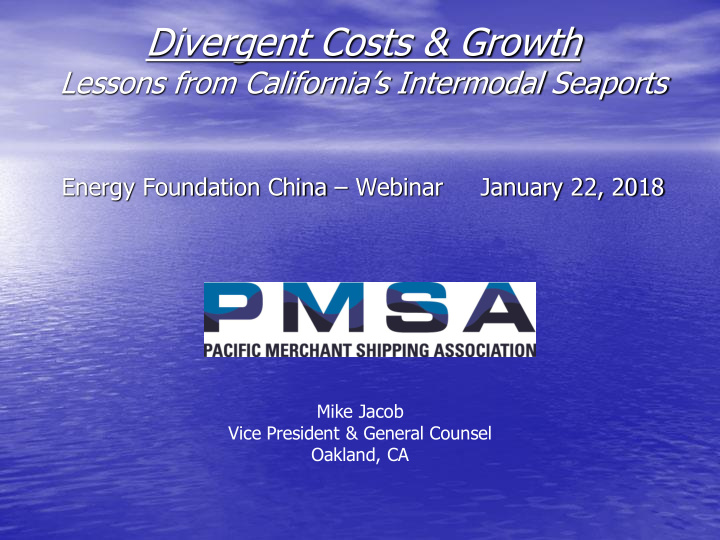



Divergent Costs & Growth Lessons from California’s Intermodal Seaports Energy Foundation China – Webinar January 22, 2018 Mike Jacob Vice President & General Counsel Oakland, CA
U.S. Seaport Infrastructure Requires Local, State, Private Financing • There is no substantial central government funding sources for Intermodal Facilities in the United States. State and local ports, private marine terminals, and railroads directly fund/finance trade infrastructure. • Exception: truck user fees/taxes which are collected nationally for highways. • Public or private, nearly all non-highway & non-transit infrastructure is financed on revenues and volume growth projections. 2
States, Local Governments and Business Invest in Ports: Jobs, economic benefits, and tax revenues grow along with volumes • Marine Terminal Operations at the Port of LA in 2007 yielded an average of $240.42 per container in State and Local tax revenues, $2,127.67 in personal income per container, and 0.23 jobs per container. • Marine Terminal Operations at the Port of Oakland in 2010 yielded an average of $180.22 in State and Local Taxes per container, $1,716.56 in personal income per container, and 0.37 jobs per container.
States & Local Governments Rely on Growth for Intermodal Seaports’ Success: • Supports existing Port and Intermodal Facility Financing • Grows jobs, economic benefits, and tax revenues along with volumes • Pays for Environmental and other costs which are in excess of original financing baselines or expectations • Lowers Average Cost & Marginal Cost for Cargo Owners per box • Leads to Virtuous Cycle of Re-investment 4
5
6
What California Growth Looked Like to Transportation Planners, Air Quality Regulators, and Underwriters: 7
8
9
11
12
13
What California Growth Looked Like to Transportation Planners, Air Quality Regulators, and Underwriters: 14
16
17
20
21
New Outstanding Costs on the Horizon Are Immense – State and Ports of LA/LB • CARB Reg Amends: • LA/LB Clean Air Action Ships At-Berth: Plan (CAAP) Update: Every vessel/Every visit/ New goals: Every port 100% ZE CHE in 2030 CHE: 100% ZE trucks in 2035 100% ZE by 2030 Estimated costs*: • SLC Reg Amends: Up to $14 billion (LA/LB) Ballast Water: 100% Up to $32 billion (M&N) exchange, $100k / call 23
California’s Average Cost Equation Base Supply Chain Costs + California Only Costs AC = Container Volumes • Unique concentration of “California Only Costs” Drive up the Numerator • Container Diversion Reduces the Denominator. • Result: Average Cost per Box Increases Demand for California Intermodal Service • Opposite of the Virtuous Cycle of Reinvestment Relative to Competitors and Volumes Go Down • Financing New Infrastructure and New Environmental Upgrades Gets More Difficult 24
Without growth in volumes it is hard to reinvest in new, more expensive ports. • Current Challenge: Lower cargo volumes than anticipated by private sector underwriting the existing infrastructure, and with higher environmental/equipment costs, leads to losses. • Future Challenge: Underwriting even greater levels of capital for new environmental infrastructure/equipment costs that are not associated with new revenue streams. 25
Dedicate Public Investment to Trade Infrastructure Which Incentivizes More Efficient ZE Port Operations • Challenge: Limited new private revenues to finance the development of new infrastructure and equipment with lower container volumes, and with higher per unit operating costs. • Answer: Use Public Subsidies for Financing. Encourage greater, accelerated adoption of Economies of Scale at Ports by Making Marine Terminals More Efficient and Denser Operations • Lower Operating Costs per Container per Acre is the Only Currently Available ZE Path Forward
Freight Policy Can Yield Greater Investments in a Low Growth Market, If Incentives Support Port Efficiency • Integrate growth and financing goals with air quality-friendly infrastructure so the investments themselves align economic and environmental goals with higher volumes • Prioritize public subsidies & incentive funding for new infrastructure and environmental mitigation programs without imposition of new regulatory mandates or facility caps • Incentivize MTOs with Public Funds to Meet Long-term 2050 Zero-Emissions Goals
Oakland, CA Long Beach, CA Seattle, WA www.pmsaship.com
Recommend
More recommend